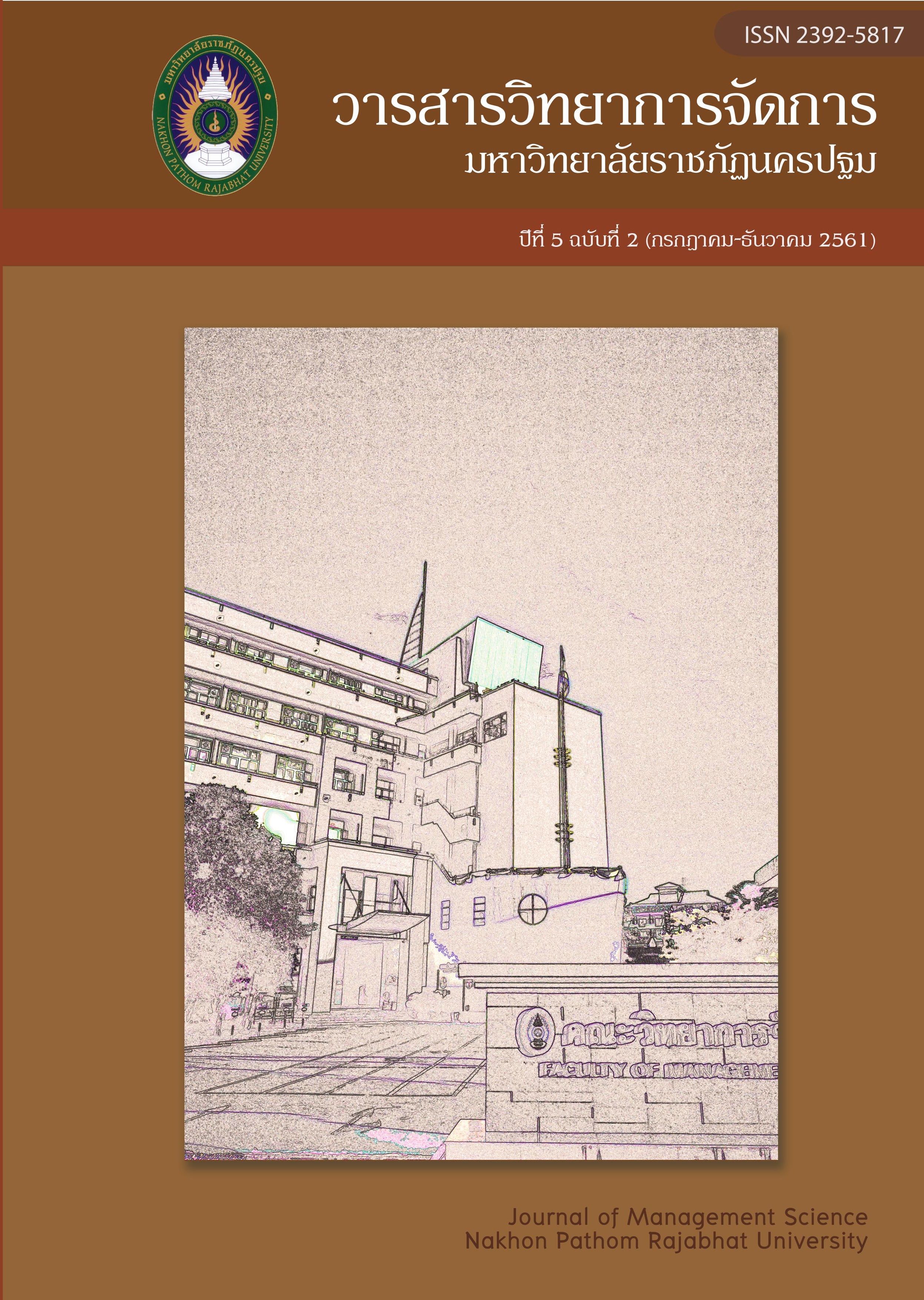Job Embeddedness Theory: A Literature Review.
Main Article Content
Abstract
In today’s business environment where employee turnover is one of the main focuses of the company, Job Embeddedness (JE) theory is gaining its popularity in academic research field. Studies found that job embeddedness is a better predictor of employee turnover than traditional factors like job satisfaction and organization commitment. Job Embeddedness theory change the perspective of how academicians study employees’ turnover from traditional view of asking why people left to why do they stay standpoint. Job Embeddedness consists of three variables that is fit, link, and sacrifice factors. Job embeddedness researches and articles particularly in Thai language is rather scarce and have not been giving much attention from Thai researchers. Therefore, the objectives of this article are to examine fundamental knowledges of job embeddedness theory, to review job embeddedness literatures, to unify Thai name of variables used in the theory, and lastly to provide additional academic article in Thai as a resource for future references.
Article history : Received 6 April 2018
Revised 11 September 2018
Accepted 21 September 2018
SIMILARITY INDEX = 0.00
Article Details
The views and opinions of the article appearing in this journal are those of the author. It is not considered a view and responsibility of the editorial staff.
References
ณัฐาพร จริยะปัญญา (2556). การวิเคราะห์โครงสร้างความสัมพันธ์ระหว่างการถ่ายทอดทางสังในองค์การ การฝังตรึงในงาน และความอยู่ดีมีสุขของพนักงานธนาคาร. การค้นคว้าอิสระคณะพัฒนาทรัพยากรมนุษย์. สถาบันบัณฑิตพัฒนบริหารศาสตร์.
ระวี อรรถวิลัย (2555). การรักษาบุคลากรทางการศึกษา สังกัดองค์การปกครองส่วนท้องถิ่น. วิทยานิพนธ์ปริญญาปรัชญาดุษฎีบัณฑิต บัณฑิตวิทยาลัย.มหาวิทยาลัยศิลปากร.
สำนักงานราชบัณฑิตยสถา. พจนานุกรม ฉบับราชบัณฑิตยสถาน พ.ศ. 2554. [ออนไลน์].ค้นเมื่อ 13 มกราคม 2561. จาก https://www.royin.go.th/dictionary/.
สำนักงานราชบัณฑิตยสถา. ศัพท์บัญญัติราชบัณฑิตยสถาน ศัพท์แพทยศาสตร์ พ.ศ. 2544. [ออนไลน์].ค้นเมื่อ 13 มกราคม 2561. จาก https://rirs3.royin.go.th/coinages/webcoinage.php.
วิริยา แก้วสง่า (2553). ปัจจัยที่มีอิทธิพลต่อการคงการทำงานของแพทย์ในโรงพยาบาลชุมชนสังกัดกระทรวงสาธารณสุข จังหวัดเชียงใหม่. การค้นคว้าแบบอิสระบริหารธุรกิจมหาบัณฑิต มหาวิทยาลัยเชียงใหม่.
สลักจิต ตันติบุญทวีวัฒน์ และคัคนางค์ มณีศรี. (2556). อิทธิพลของความเป็นส่วนหนึ่งในงาน ความพีงพอใจในงานและความผูกพันกับองค์การต่อความตั้งใจลาออก. วารสารวิชาการ Veridian E-Journal . 6 (3) : 699-717.
อรยา วิศวไพศาล และเขมกร ไชยประสิทธิ์. (2558). ความฝังตรึงในงานของพนักงานฝ่ายวิจัยทางคลินิกในประเทศไทยขององค์การรับทำวิจัยตามสัญญา. วารสารบริหารธุรกิจ มหาวิทยาลัยเชียงใหม่.1 (4) : 463-479.
Crossley, C., Bennett, R., Jex, S.M., & Burnfield, J. (2007). Development of a global measure of job embeddedness and integration into a traditional model of voluntary turnover. Journal of Applied Psychology, 92 (4), 1031-1042.
Darrat, M.A., Burton, D.A., & Bennett, R.J. (2017). Examining the impact of job embeddedness on salesperson deviance: The moderating role of job satisfaction. Industrial Marketing Management, 22(63), 158-166.
Herzberg, F. (1996). Work and the nature of man. Cleveland: World Publishing.
Holtom, B.C., & Inderrieden, E.J. (2006). Integrating the unfolding model and job embeddedness model to better understand voluntary turnover. Journal of Managerial Issues, 18(4), 435-452.
Holtom, B.C., Mitchell, T.R., & Lee, T.W. (2006). Increasing human and social capital by applying job embeddedness theory. Organizational Dynamics, 35 (4), 316-331.
Holtom, B.C., Mitchell, T.R., Lee, T.W., & Eberly, M.B. (2008). Turnover and retention research: A glance at the past, a closer review of the present, and a venture into the future. Academy of Management Annals, 2 (1), 231-274.
Holtom, B.C., & O’Neill, B.S. (2004). Job embeddedness: A theoretical foundation for developing a comprehensive nurse retention plan. Journal of Nursing Administration, 34(5), 216-227.
Jiang, K., Liu, D., McKay, P.F., Lee, T.W., & Mitchell, T.R. (2012). When and how is job embeddedness predictive of turnover? A meta-analysis investigation. Journal of Applied Psychology. 97(5), 1077-1096
Jones, C.B. (2004). The costs of nurse turnover: Part 1: An economic perspective. Journal of Nursing Administration, 34(12), 562-570.
Lawrence, T.B., & Robinson, S.L. (2007). Ain’t misbehaving: Workplace deviance as organizational resistance. Journal of Management, 33(3), 378-394.
Lee, T.W., Burch, T.C., & Mitchell, T.R. (2014). The story of why we stay: A review of job embeddedness. The annual review of organizational psychology and organizational behavior, 1, 199-216
Lee, T.W., Mitchell, T.R., Sablynski, C.J., Burton, J.P., & Holtom, B.C. (2004). The effects of job embeddedness on organizational citizenship, job performance, volitional absences, and voluntary turnover. Academy of Management Journal, 47(5), 711-722.
Lewin, K. (1951). Field theory in social science. New York: Harper and Row.
Mitchell, T.R., Holtom, B.C., Lee, T.W., Sablynski, C.J., & Erez, M. (2001). Why people stay: Using job embeddedness to predict voluntary turnover. Academy of Management Journal, 44(6), 1102-1121.
Mitchell, T.R., & Lee, T.W. (2001). The unfolding model of voluntary turnover and job embeddedness : Foundations for a comprehensive theory of attachment. Research in Organizational Behavior, 23, 189-246.
Monday, R.T., Porter, L.M., & Steer, R.M. (1982). Employee-organization linkages: The psychology of commitment, absenteeism and turnover. New York: Academic Press.
Ramesh, A., & Gelfand, M.J. (2010). Will they stay or will they go? The role of job embeddedness in predicting turnover in individualistic and collectivistic cultures. Journal of Applied Psychology, 95(5), 807-823.
Reitz, O.E., & Anderson, M.A. (2011). An overview of job embeddedness. Journal of professional nursing, 27(5), 320-327.
Thau, S., Crossley, C., Bennett, R.J., & Sczesny, S. (2007). The relationship between trust, attachment, and antisocial work behaviors. Human Relations, 60(8), 1155-1179.


